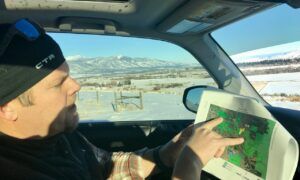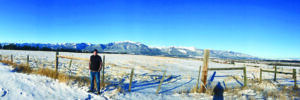
The Bitter Root Land Trust has made a lot of headway since it opened its doors in 1996 and set out on a mission to conserve open lands and working farms in the Bitterroot valley. By engaging with private landowners and facilitating the voluntary placement of conservation easements on private property throughout the county, they have succeeded in protecting almost 10,000 acres of land in the valley from future development. This includes about 7,500 acres of local family farm and ranch lands that will remain as working farms in perpetuity. It includes 20 miles of river and stream frontage and 4,500 acres of forest and rangeland kept intact and free from development. It also includes three riverfront community access properties and nature trails.
“We’ve sure been fortunate that so many landowners have made this decision,” said Bitter Root Land Trust Executive Director Gavin Ricklefs while standing on benchland overlooking the Burnt Fork drainage. “The valley’s going to be better for it.”
The collection of conservation easements up the Burnt Fork of the Bitterroot could well be called the crown jewels of the county’s Open Lands Bond Program.
Ricklefs was on the job when one of the first conservation easements to be placed by the land trust was negotiated with local veterinarian Stan Swartz on his ranch up Lost Horse. Interest in the conservation tool increased, but it was when the general public weighed in, passing the Open Lands Bond in 2006, that things really began to take off.
Dan and Debbie Severson were the first property owners in the Burnt Fork area to place an easement on a good portion of the Flying E Ranch. “The Open Lands Bond was the catalyst,” said Dan Severson. “Basically, it was the people of Ravalli County when they voted for the Open Lands Bond and said ‘Hey, we appreciate farm ground and open lands and wildlife’ and were willing to take a few bucks out of their pockets to promote that.”
“I think that was the turning point for a lot of us,” said Severson, “for me for sure, when I realized that my neighbors appreciated open space enough to support it. Fifty years from now, a hundred years from now, people are still going to really appreciate this. I think it will keep our community a beautiful place to live.”
Other funding that has helped fuel the establishment of so many conservation easements in the Burnt Fork is a significant amount of funding over the years from the Friends of the Lee Metcalf Refuge. That organization recognized the value of the easements in protecting a flyway corridor connecting the Sapphire Mountains to the Metcalf Refuge.
According to Ricklefs, if the next conservation easement on the Haywire Ranch on the Burnt Fork, already approved by the Open Lands Board, gains the approval of the County Commissioners, it would establish a necklace of conservation easements down the Burnt Fork stretching unbroken from the National Forest all the way to Logan Lane.

The Bitter Root Land Trust has also leveraged a significant amount of federal funding, through the Farm Bill, aimed at preserving family farms, to make the open lands bond fund money go even further. Currently about one quarter of the original $10 million Open Lands Bond remains.
“We are fortunate that we are still in a position in our valley that we can protect our agriculture and wildlife and open lands and the beauty of this place,” said Ricklefs. He said the conservation easement was showing itself to be a very good tool for identifying and protecting what the community finds of value.
“It’s totally voluntary, incentive-based, landowner and community-driven,” he said.
Sharon Schroeder, who has served on the Open Lands Board for nine years, the last three as Chair, said that she has seen an incredible metamorphosis in the program since 2012.
“I’m just so grateful for these landowners who value the land and want to do the right thing for the land,” said Schroeder. “They are being such good stewards of the land. They have so much opportunity to make so much more money by taking the development route. Bless them for understanding that once it’s gone, it’s gone forever. We are so unbelievably blessed in the Bitterroot and especially in the Burnt Fork.”
Schroeder and her husband Jim sold the family ranch at the north end of the valley and bought three properties on Sunset Bench, overlooking the Burnt Fork. They placed a conservation easement on the property using the Open Lands Bond Program and have been strong advocates of the process.
“It’s a long and difficult process because so much emotion ties up in it,” she said. “But in the end, it’s very rewarding to feel like you’ve done the right thing for future generations.”
Ricklefs said that at times of rapid develop everyone becomes concerned about the amount of growth that is occurring and the amount of change that goes with it.
“Anyone who has lived in the valley, for any amount of time really, recognizes what it is that draws people here and makes it such a special place.”
“That growth is going to continue and with it will come a lot of changes that are not all bad,” he said. “Growing and dynamic communities bring a lot of good things to the valley. But if we don’t invest in what we have that is drawing everyone here and makes it so special, then we all lose.”
“We are unique,” he said, “with all the 10-acre Orchard Tracts created at the end of the last century. What I think a lot of people don’t realize is how much of the open land you see is actually already subdivided and could be sold in 10 acre blocks at any time.” Those 10-acre blocks can then be divided into two five-acre lots and each of those then divided into five one-acre lots, all without ever going through major subdivision review.
Ricklefs said that more and more people are looking at those tracts and trying to save them from division. He said the land trust has no desire to see 1000 acres of ag land go to houses. He said those projects are high priority right now for the land trust because they are already set up to sell.
“What’s encouraging to me in times like this, especially in these pulses of activity, is how everybody feels it and the sense that we need to act. People really care about this place and it’s independent of politics, tax bracket, or occupation. There is this thing that we all care about so much. We take that awe and respect for what’s all around us and bring it down to the places we’ve got here that connect us to it,” said Ricklefs.
Deborah Laster says
It is Wonderful to know that other people feel the same way I do about open lands.